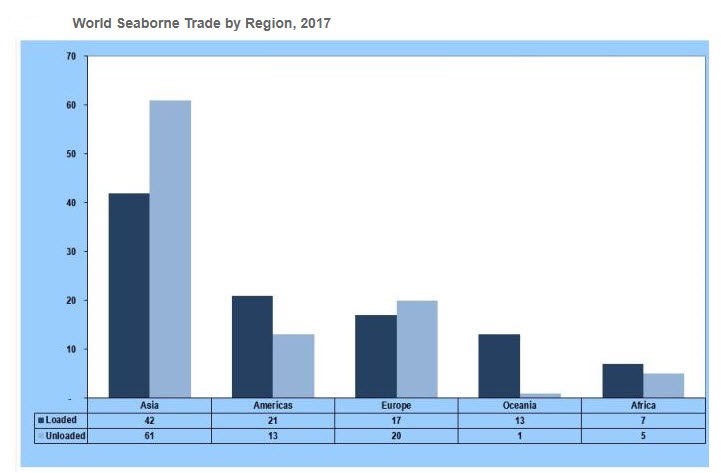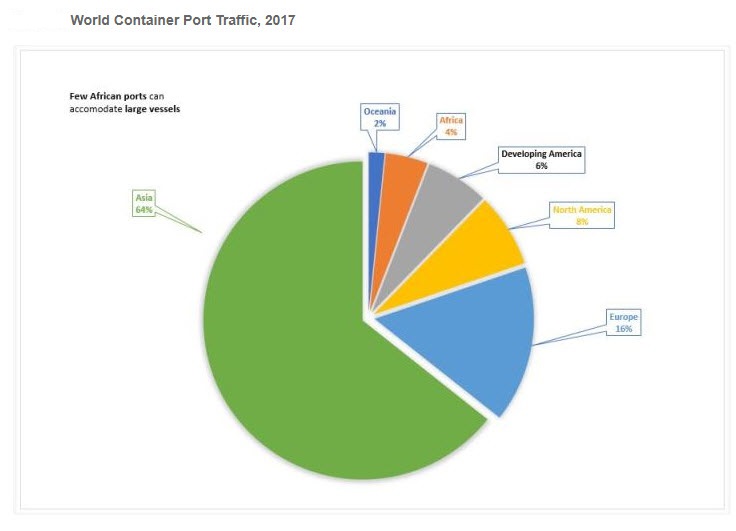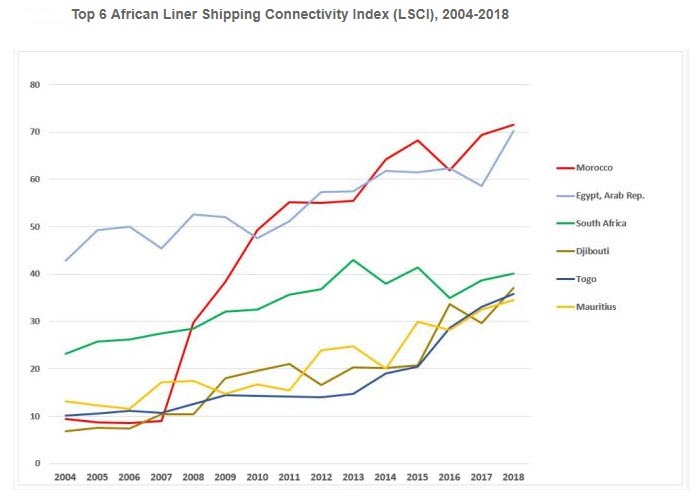Fulfilling Africa's Maritime Trade Potential
Africa currently has minimal integration in world trade, but this is an enormous opportunity for the world’s youngest and second-most populous continent, states UNCTAD's newly-released Review of Maritime Transport 2018.
One-third of African countries are landlocked, but maritime transport remains the main gateway to the global marketplace. While it accounts for approximately 2.7 percent of global trade by value, the continent contributes seven percent to global seaborne trade and five percent of maritime exports and imports by volume.
The report states that maritime trade in Africa is shaped by the continent’s trade concentration and limited diversification. Accordingly, crude oil accounted for 40 percent of exported by sea in 2017, and over two-thirds of imports consisted of dry bulk cargoes and containerized goods. Close to 20 percent of imports were made up of petroleum products and gas.
The European Union remains Africa’s major trading partner although its share of trade has declined from about half in 1995 to one-third in 2017. In recent years, the share of trade with the U.S. has fallen while trade with China has increased: China, and Asia in general, have incrementally cut into the E.U. and U.S. share of African trade. This is opening new opportunities for the continent both as a consumer market as well as a potential manufacturing region, for example, as shown by growing textile and garment manufacturing activity in Ethiopia.

Graph courtesy of UNCTAD – Review of Maritime Transport 2018.
Africa’s ports account for four percent of global containerized trade volume, much of which comprises imports of manufactured goods.
The report advises that by diversifying their economies and enabling greater integration into regional and global value chains, Africa can improve its containerized trade and port traffic volumes and emerge as an exporter of containerized goods. For this to happen, however, trade policy and regional integration initiatives such as the African Continental Free Trade Agreement (AfCFTA) will not be enough.
Africa’s container ports and hinterland transport networks need to support these efforts by upgrading infrastructure and services, and improving performance, to match international standards. This entails, among other things, enhancing productivity levels: on average, crane productivity is around 20 moves per crane per hour in West Africa, 25 to 30 in South Africa, and 35 to 40 in Asia.

Graph courtesy of UNCTAD – Review of Maritime Transport 2018.
Shipping connectivity, which significantly influences transport cost levels, is below the global average in Africa. The best-connected countries include Morocco, Egypt and South Africa. They are followed by Djibouti, Togo and Mauritius. Combinations of public and private investments, port reforms and improved transit to connect to neighboring landlocked countries have helped these countries to become leaders in African container shipping connectivity.

Graph courtesy of UNCTAD – Review of Maritime Transport 2018.
The continent’s ownership of the world fleet is limited, with no African country among the top 35 shipowning nations in 2017. Additionally, only Liberia makes the list of top flag states, ranking third globally after Panama and Marshall Islands regarding nationally flagged tonnage.
While many challenges constrain the continent’s ability to fully take its place in the global economic arena, several factors on the upside suggest that Africa is a dormant giant. These include robust economic growth, a demographic dividend, resources, growing investment and financing commitments relating to transport infrastructure, including by China.
UNCTAD supports Africa in these endeavors with several flagship programs. These include port management, trade facilitation and sustainable freight transport technical assistance programs, as well as close collaboration with the African Union towards achieving the AfCFTA. UNCTAD also actively supports customs reforms with its ASYCUDA program, which is implemented in most African countries.
Measures that could be taken to help Africa fulfill its potential include:
• Preparing African ports to accommodate larger vessels through dredging for water depth and ensuring adequate cargo handling equipment is in place.
• Improving access to the hinterland and landlocked countries by multi-modal transport and transport corridor approaches and building inland transport infrastructure.
• Making use of relevant technologies and digital solutions to facilitate transport and trade, cutting inefficiencies, improving processes and enhancing transparency and promoting security and resilience of transport systems.
• Enhancing transport connectivity either on the sea or land side to reduce transport costs and improve African countries’ position in the global shipping networks. This also must encompass enabling soft infrastructure in support of transit transport and trade facilitation by harmonizing transport regulation, including road and rail transport.
• Encouraging greater participation in maritime business by promoting maritime clusters where shipping and port activities can boost related services sectors, including in the context of the Blue Economy.
